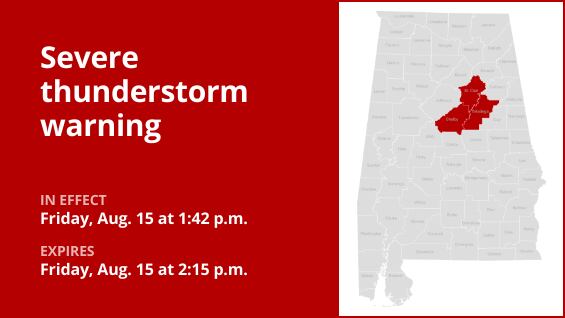The National Weather Service issued a revised severe thunderstorm warning for St. Clair, Shelby, and Talladega counties at 1:42 p.m. on Friday, which was in force until 2:15 p.m.
Be ready for wind gusts of up to 60 mph and hail the size of a quarter (1 inch).
“At 1:42 p.m., a severe thunderstorm was located near Vincent, or 10 miles southeast of Leeds, and is nearly stationary,” states the meteorological service. “Car damage from hail is anticipated. Expect trees, siding, and roofs to sustain wind damage.
Childersburg, Vincent, Harpersville, Vandiver, Alpine Bay Resort, Coosa Island, Logan Martin Dam, Logan Martin Lake, Camp Winnataska, Sterrett, and Shoal Creek are among the places affected by the warning.
It says, “For your protection, move to an interior room on the lowest floor of a building.”
Lightning on the horizon: Expert safety measures for thunderstorms
About 25 million lightning strikes occur in the US annually, primarily in the summer. The weather service estimates that it kills around 20 people a year. As thunderstorms get closer, the risk of lightning increases; it peaks when the storm is directly overhead and then progressively decreases as it passes.
Remember the following advice to stay safe during a thunderstorm:
Plan for lightning safety:
-
When venturing outdoors, it’s vital to establish a clear plan for seeking shelter in case of lightning.
-
Monitor the sky for threatening signs and listen for the sound of thunder. If thunder is audible, it’s an indication that lightning is nearby.
-
Seek shelter promptly in a safe location, preferably indoors.
Indoor safety precautions:
-
Once you’re indoors, avoid using corded phones, electrical devices, plumbing fixtures, and stay away from windows and doors.
-
These precautions help reduce the risk of electrical surges, as lightning can follow conductive pathways.
Hold off till the all-clear:
-
After the last lightning strike or thunderclap, wait at least 30 minutes before resuming outdoor activities.
-
Lightning can strike even when a storm has seemingly passed, so exercise caution.
When there is no indoor shelter:
Take these precautions to increase your safety if you are outside during a thunderstorm without access to indoor shelter:
-
Avoid open fields, hilltops, or ridge crests, as they expose you to greater lightning risk.
-
Steer clear of tall, isolated trees and other prominent objects. In wooded areas, stay close to lower stands of trees.
-
If you’re with a group, ensure individuals are spread out to prevent lightning current from transferring between people.
-
Camping in an open setting during a thunderstorm is strongly discouraged. If no alternative exists, set up camp in a valley, ravine, or other low-lying areas. Remember that a tent offers no protection against lightning.
-
Do not approach water bodies, wet objects, or metal items. Although water and metal do not attract lightning, they conduct electricity effectively and can pose significant risks.
In conclusion, being alert and ready are your best defenses against lightning threats. You may put your safety first and drastically lower the likelihood of lightning-related mishaps by adhering to these rules.
Driving through downpours: Safety guidelines for wet roads
Safety comes first when there is a lot of rain. To avoid dangers and navigate wet roads, arm yourself with these weather service guidelines:
Watch out for swift water flow:
Avoid parking or strolling close to culverts or drainage ditches during periods of intense precipitation, as the swift-moving water can be quite dangerous.
Keep your distances from other vehicles safe:
In heavy rain, the two-second rule of following distance is your friend. To guarantee safe spacing under unfavorable circumstances, increase it to four seconds.
Slow down and drive carefully:
Reduce your speed if it’s raining and the roads are wet. Reduce your speed gently by taking your foot off the accelerator. Never apply the brakes abruptly since this could cause the vehicle to slide.
Pick your lane carefully:
To reduce the chance of hydroplaning, stay in the middle lanes. Water is more likely to accumulate in outside lanes.
Put visibility first.
Turn on your headlights to improve visibility in severe rain. Rain-stained windows can make it difficult to see cars in blind zones, so be especially alert for them.
Be cautious on slick roads:
Roads are slickest during the first half-hour of rain because of a combination of rain, oil, and filth. Be especially careful during this time.
Stay a safe distance away from big cars:
Tire spray from big vehicles and buses can make it harder to see. Be careful when passing and refrain from tailgating.
Be mindful of your wipers:
Visibility may be hampered by overloaded wiper blades. If the rain significantly impairs your vision, stop and wait for the weather to clear up. Seek cover in safe spaces or rest areas.
Position your car as far off the road as you can, preferably beyond guardrails, if stopping by the side of the road is your only choice. To let other cars know where you are, turn on your emergency flashers and keep your headlights on.
Taking these safety measures will significantly improve your road safety while it’s raining a lot. For a safe trip, keep yourself updated on weather conditions and follow local authorities’ instructions.
United Robots offers a service called Advance Local Weather Alerts that gathers the most recent information from the National Weather Service using machine learning.






